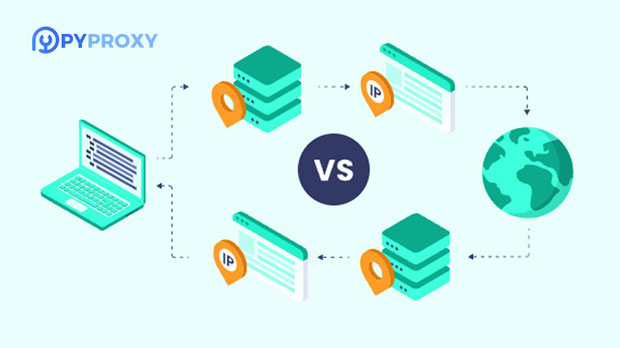Which is better in terms of performance when using ProxyEmpire vs PYProxy rotating residential proxies?
In today’s digital world, proxies have become an indispensable tool for businesses and individuals alike. When it comes to rotating residential proxies, ProxyEmpire and PYPROXY are two names that often come up for comparison. These services are designed to help users maintain anonymity, bypass geo-restrictions, and scrape data at scale. However, the question arises: which one offers better performance? In this article, we will delve into a detailed analysis of both ProxyEmpire and PYProxy, examining their features, performance, reliability, and use cases. By the end of this piece, readers will have a clear understanding of which service may best suit their needs. Understanding Residential Proxies and Their ImportanceBefore diving into a comparison of ProxyEmpire and PYProxy, it's important to understand the core concept of residential proxies and why they are crucial. Residential proxies are IP addresses provided by real residential devices rather than data centers. This makes them harder to detect and block by websites and online services, providing a high level of anonymity. They are especially useful for activities like web scraping, social media automation, and accessing restricted content based on location. rotating residential proxies further enhance this by automatically changing the IP address assigned to a user at regular intervals or per request, allowing for continuous anonymous browsing without the risk of being blocked. Both ProxyEmpire and PYProxy offer these services, but how do they stack up against each other in terms of performance?ProxyEmpire: Performance OverviewProxyEmpire is known for offering a large pool of residential IP addresses, which is essential for users who need to rotate their proxies frequently. The service claims to provide access to millions of residential IPs across various locations worldwide. Performance is one of the key selling points of ProxyEmpire, as it focuses on providing fast and reliable connections for tasks such as data scraping, sneaker bots, and social media automation.One of the standout features of ProxyEmpire is its advanced rotation system. The proxies are designed to rotate seamlessly without interrupting the user’s tasks. This ensures that web scraping and other activities run smoothly without the risk of encountering blocks or CAPTCHAs. Furthermore, ProxyEmpire offers flexible pricing plans, allowing users to choose a package that fits their needs based on the amount of bandwidth and IP rotations required.However, while ProxyEmpire excels in terms of speed and reliability, there are occasional reports of slower response times during peak usage hours. This can be a concern for users who require uninterrupted performance during high-demand periods. Despite this, ProxyEmpire remains a solid choice for many users, particularly those who prioritize large-scale data extraction.PYProxy: Performance OverviewPYProxy, on the other hand, has built a reputation for offering competitive pricing along with solid performance. Like ProxyEmpire, PYProxy provides access to a wide pool of residential IP addresses. However, what sets PYProxy apart is its focus on minimizing downtime and offering an optimized experience for users involved in web scraping and other high-volume tasks.PYProxy offers a robust proxy rotation mechanism that ensures seamless IP rotation without disruptions. This makes it an attractive choice for users who rely heavily on uninterrupted access to online resources. The service also boasts low latency, which is an essential factor for high-performance applications such as gaming, browsing, or scraping websites in real-time.A key differentiator for PYProxy is its geo-targeting capabilities. The service allows users to access specific geographic locations with ease, which is beneficial for users engaged in localized data collection or market research. Additionally, PYProxy offers excellent customer support, ensuring that users can resolve any technical issues promptly.One downside to PYProxy is its somewhat limited pool of IP addresses compared to ProxyEmpire. While the available IPs are still sufficient for most users, those requiring access to a broader range of IPs might find this to be a limitation. Nonetheless, PYProxy remains a strong contender for users looking for a cost-effective solution with good performance.Performance Comparison: Speed, Reliability, and RotationWhen comparing ProxyEmpire and PYProxy based on speed, reliability, and proxy rotation, both services perform admirably, but with slight differences.- Speed: ProxyEmpire is generally faster in terms of initial connection times, thanks to its large IP pool and efficient rotation system. However, during periods of heavy usage, users may experience slower response times. PYProxy, on the other hand, offers a more stable and consistent speed throughout the day, though its initial connection times can sometimes be slightly longer.- Reliability: Both services offer excellent reliability, but ProxyEmpire’s larger pool of IPs can lead to occasional slowdowns during peak hours, especially for users in less popular regions. PYProxy, while having fewer IPs, is known for its stable performance even during high-demand periods. Therefore, users who prioritize stability might lean towards PYProxy.- Rotation: ProxyEmpire offers an advanced rotation system that ensures smooth transitions between IPs, reducing the chances of encountering CAPTCHA screens or IP bans. PYProxy also provides seamless IP rotation, though some users report slightly less flexibility in switching IPs as often as needed. Both services allow for automatic and manual rotation, but ProxyEmpire’s system is generally more robust for large-scale tasks.Use Case Scenarios: Which Service is Right for You?- Large-Scale Web Scraping: If your primary use case involves large-scale data scraping, ProxyEmpire’s vast IP pool and fast rotation system will likely serve you better. The service is built for high-demand tasks, providing quick and reliable access to a diverse range of websites.- Geo-Targeted Data Collection: If your focus is on collecting data from specific locations, PYProxy’s geo-targeting feature might give it an edge. With its ability to pinpoint exact geographic areas, PYProxy is ideal for localized data scraping or market research.- Cost-Effective Solutions: For users looking for an affordable solution without sacrificing too much in terms of performance, PYProxy offers a competitive pricing structure. It may have a smaller IP pool, but it delivers solid performance and customer support at a reasonable cost.- Uninterrupted Access: If you need a proxy service that can guarantee uninterrupted access to resources, especially during peak traffic times, PYProxy might be the better choice. Its focus on minimizing downtime makes it ideal for users who can’t afford delays.Conclusion: Which One Wins?Both ProxyEmpire and PYProxy are strong contenders in the rotating residential proxy market, but the best choice depends on your specific needs. If you require a larger IP pool, faster speeds, and the flexibility to rotate proxies frequently, ProxyEmpire stands out. However, if stability, low latency, and cost-effectiveness are your main priorities, PYProxy is the better option.In the end, the performance of each service is closely tied to the scale and type of tasks you need to perform. By evaluating the features, performance metrics, and pricing of both services, you can make a more informed decision about which provider aligns best with your business or personal goals.
2025-02-25

























































